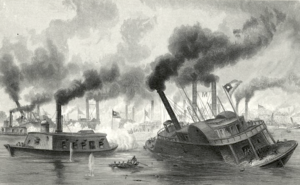Battle of Memphis
| First Battle of Memphis | |||||||
|---|---|---|---|---|---|---|---|
| Part of American Civil War | |||||||
 Battle of the rams. Ward, A. R., artist |
|||||||
|
|||||||
| Belligerents | |||||||
|
|
|
||||||
| Commanders and leaders | |||||||
|
Charles Henry Davis Charles Ellet, Jr. † |
James E. Montgomery M. Jeff Thompson |
||||||
| Units involved | |||||||
|
Benton Louisville Carondelet Cairo St. Louis Queen of the West Monarch |
CSS General Beauregard CSS General Bragg CSS General Sterling Price CSS General Earl Van Dorn CSS General M. Jeff Thompson CSS Colonel Lovell CSS General Sumter CSS Little Rebel |
||||||
| Strength | |||||||
| 5 ironclads 2 rams |
8 rams | ||||||
| Casualties and losses | |||||||
| 1 | ~180 | ||||||
The First Battle of Memphis was a naval battle fought on the Mississippi River immediately above the city of Memphis on June 6, 1862, during the American Civil War. The engagement was witnessed by many of the citizens of Memphis. It resulted in a crushing defeat for the Confederate forces, and marked the virtual eradication of a Confederate naval presence on the river. Despite the lopsided outcome, the Union Army failed to grasp its strategic significance. Its primary historical importance is that it was the last time civilians with no prior military experience were permitted to command ships in combat. As such, it is a milestone in the development of professionalism in the United States Navy.
The defending Confederates closely matched the advancing federal force in raw numbers, with eight rebel vessels opposing nine Union gunboats and rams, but the fighting qualities of the former were far inferior. Each was armed with only one or two guns, of a light caliber that would be ineffective against the armor of the gunboats. The primary weapon of each was its reinforced prow, which was intended to be used in ramming opponents.
The Confederate rams were distinguished by a unique feature of their defense against enemy shot. Their engines and other interior spaces were protected by a double bulkhead of heavy timbers, covered on the outer surface by a layer of railroad iron. The gap between the bulkheads, a space of 22 in (56 cm), was packed with cotton. Although the cotton was the least important part of the armor, it caught the public's attention, and the boats came to be called "cottonclads". Later in the war, ships' crews were often protected from small-arms fire by bales of cotton placed in exposed positions, and these vessels were also referred to as "cottonclads". They differed, however, from the originals of the category.
The federal force consisted of five gunboats, four of which were known semi-officially as "Eads gunboats", after their builder, James Buchanan Eads, but more commonly as "Pook turtles", after their designer, Samuel M. Pook, and their strange appearance. The fifth gunboat, flagship Benton, was also a product of the Eads shipyards, but was converted from a civilian craft. Each of these vessels carried from 13–16 guns. The other four vessels were rams, with no armament whatever, aside from the small arms carried by the officers. All of the rams had been converted from civilian riverboats, and had no common design.
...
Wikipedia
